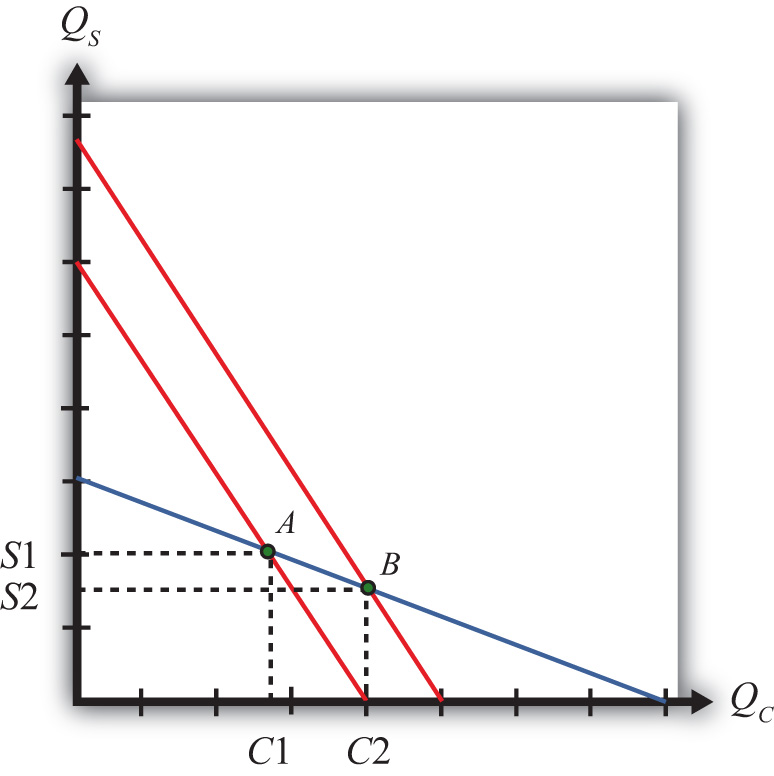This is “The Rybczynski Theorem”, section 5.4 from the book Policy and Theory of International Economics (v. 1.0). For details on it (including licensing), click here.
For more information on the source of this book, or why it is available for free, please see the project's home page. You can browse or download additional books there. To download a .zip file containing this book to use offline, simply click here.
5.4 The Rybczynski Theorem
Learning Objective
- Use the PPF diagram to show how changes in factor endowments affect production levels at full employment.
The Relationship between Endowments and Outputs
The Rybczynski theorem demonstrates how changes in an endowment affect the outputs of the goods when full employment is maintained. The theorem is useful in analyzing the effects of capital investment, immigration, and emigration within the context of a Heckscher-Ohlin (H-O) model. Consider Figure 5.2 "Graphical Depiction of Rybczynski Theorem", depicting a labor constraint in red (the steeper lower line) and a capital constraint in blue (the flatter line). Suppose production occurs initially on the PPF at point A.
Figure 5.2 Graphical Depiction of Rybczynski Theorem

Next, suppose there is an increase in the labor endowment. This will cause an outward parallel shift in the labor constraint. The PPF and thus production will shift to point B. Production of clothing, the labor-intensive good, will rise from C1 to C2. Production of steel, the capital-intensive good, will fall from S1 to S2.
If the endowment of capital rose, the capital constraint would shift out, causing an increase in steel production and a decrease in clothing production. Recall that since the labor constraint is steeper than the capital constraint, steel is capital intensive and clothing is labor intensive.
This means that, in general, an increase in a country’s endowment of a factor will cause an increase in output of the good that uses that factor intensively and a decrease in the output of the other good.
Key Takeaways
- The Rybczynski theorem shows there is a positive relationship between changes in a factor endowment and changes in the output of the product that uses that factor intensively.
- The Rybczynski theorem shows there is a negative relationship between changes in a factor endowment and changes in the output of the product that does not use that factor intensively.
Exercises
-
Jeopardy Questions. As in the popular television game show, you are given an answer to a question and you must respond with the question. For example, if the answer is “a tax on imports,” then the correct question is “What is a tariff?”
- Of increase, decrease, or stay the same, the effect on the output of the capital-intensive good caused by a decrease in the labor endowment in a two-factor H-O model.
- Of increase, decrease, or stay the same, the effect on the output of the labor-intensive good caused by a decrease in the labor endowment in a two-factor H-O model.
- Of increase, decrease, or stay the same, the effect on the output of the capital-intensive good caused by an increase in the capital endowment in a two-factor H-O model.
- Of increase, decrease, or stay the same, the effect on the output of the labor-intensive good caused by a decrease in the capital endowment in a two-factor H-O model.
- Consider an H-O economy in which there are two countries (United States and France), two goods (wine and cheese), and two factors (capital and labor). Suppose an increase in the labor force in the United States causes cheese production to increase. Which factor is used intensively in wine production? Which H-O theorem is applied to get this answer? Explain.




